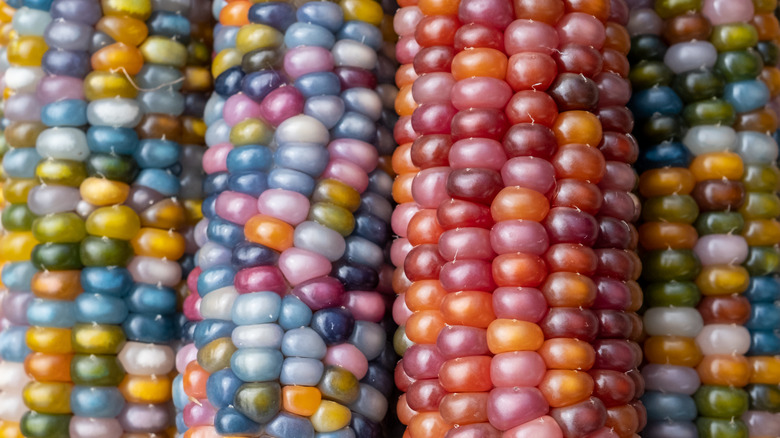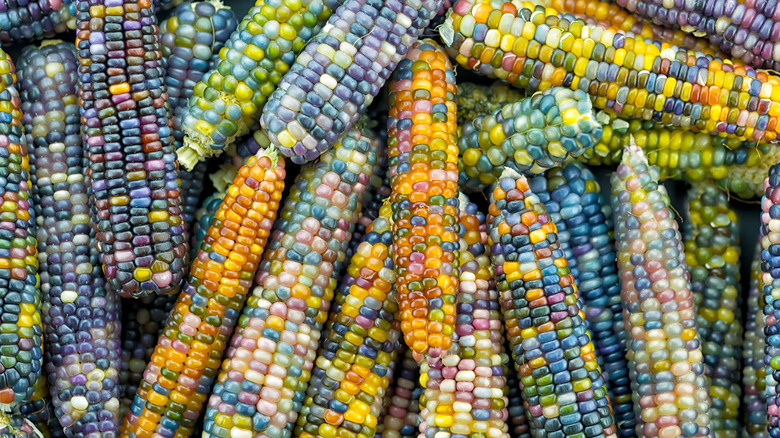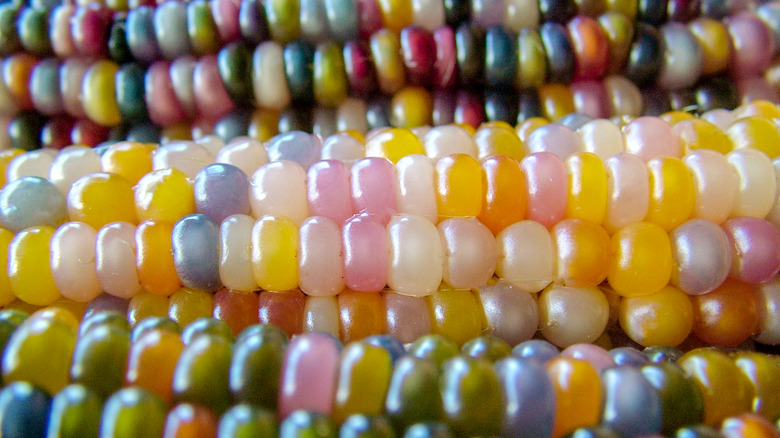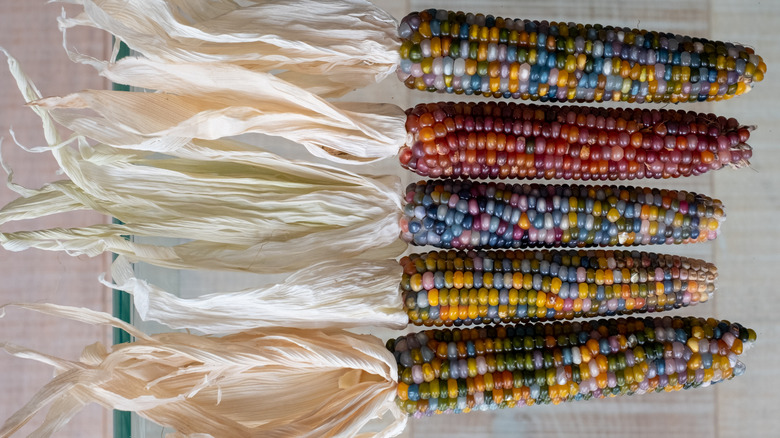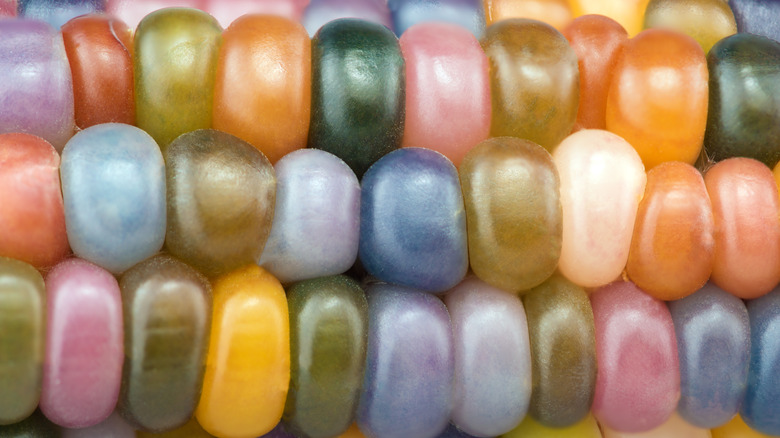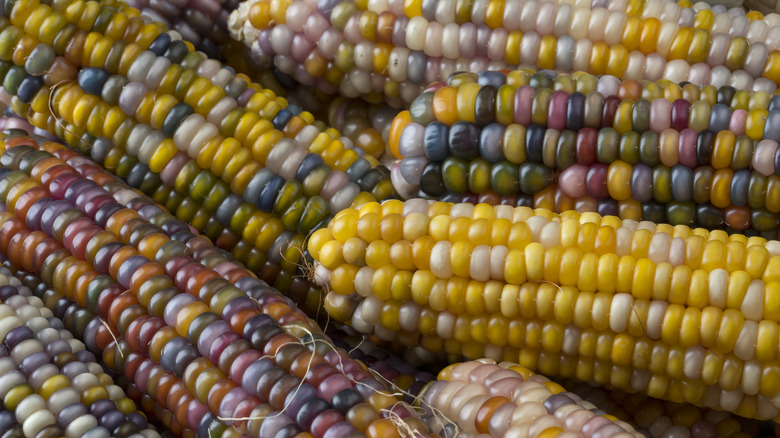What Is Glass Gem Corn And Why Is It So Colorful?
We may receive a commission on purchases made from links.
With fall harvest in full swing and cooler weather on the horizon, now is the perfect time to embellish your home with festive flair and cook meals with the most delicious and versatile in-season crops. If you want to add a splash of wholesome color to your holiday decorations and meals this year, consider buying a few ears of glass gem corn. Glass gem corn (Zea mays) is not your average grain. Its name says it all: The multicolored flint corn caught the eyes of millions of social media users back in 2012 when photos of the radiant variety went viral on visual-centric networks like Instagram and Facebook, per ABC.
The polychromatic kernels of glass gem corn resemble brilliant gemstones, strands of glass beads, or even jelly beans — hence the name. But believe it or not, glass gem corn is not at all dyed, nor painted. Let's explore more about this eye-catching bit of produce that will have your impressed friends and house guests asking how you stumbled upon such magic.
What is glass gem corn and how is it made?
Glass gem corn, also known as "Indian" or "calico" corn, is a species native to North America (via Little Things). According to an Instagram post by Gastro Obscura, glass gem corn was invented by Carl Barnes, a part-Cherokee farmer who lived in Oklahoma. To create the multicolored ears, he collected ancient corn seeds and cross-bred several ancestral corn varieties together, which resulted in a single ear containing a spectrum of hues.
Barnes, who died in 2016, dedicated his farming career to preserving the seeds of traditional Native American corn varieties as a way of staying true to his roots (via Business Insider). In order to create his masterpiece, Barnes simply replanted the seeds from the most colorful cobs, experimenting with different patterns and colors over the years. As he got older and knew he had to retire from agriculture, Barnes thoughtfully passed down his seed collection to his protégé Greg Schoen, who then shared the seeds with another fellow farmer, Bill McDorman, reports Native Seeds. As far as glass gem corn's optimal climate goes, the jewel-colored ears need to be grown in a hot and dry environment. This type of corn can be harvested 110 to 120 days after planting.
What does glass gem corn taste like?
Corn was a staple crop of indigenous Americans. It is believed to be one of the oldest agricultural crops in history, perhaps originating in Mexico, according to Rural Sprout. Tribes cultivated their own distinct strains, which became heirlooms that represented their heritage. Glass gem corn sure is gorgeous, but how does it taste? Is it just like any old corn on the cob? According to Business Insider, glass gem corn is a type of flint corn, which refers to the kernels' hard outer layer. This makes it a bit starchier than other softer, sweeter varieties.
Mark Valencia, an Australian organic gardener who runs the blog Self Sufficient Me, grew glass gem corn in his home garden and explained its unique flavor to his YouTube viewers. When he cooked up some of the stuff for his family, he described the texture as extra chewy and fibrous. He admitted that his wife and children didn't love the flavor or texture of glass gem corn, but he was personally a big fan. "For those of you who really appreciate homegrown food, I recommend you give it a go, nice and fresh, on the cob," Valencia suggests. If that doesn't sound up your alley, Rural Sprout recommends grinding it into cornmeal or using it to make popcorn or hominy.
How do you cook with glass gem corn?
Although glass gem corn may be considered too pretty to eat by many consumers, if you do decide to use it as an ingredient in corn recipes, you have plenty of options. You can grind it up for a batch of homemade tortillas or cornmeal, for one. Mark Valencia of YouTube recommends using glass gem cornmeal as a thickener for soups and stews, making grits for a hearty meal, or using it just like breadcrumbs to coat chicken breasts and other meats for a pleasant, savory crunch.
The colorful kernels are too hard to eat off the cob, but they can be popped into popcorn for a fun movie night treat, per Rural Sprout. Keep in mind that when you grind up or cook with glass gem corn, its bright colors won't be as visible as you may expect. And while it is indeed totally edible, glass gem corn was originally grown to be ornamental, according to Native Seeds. Lay a few ears out on your dining room table or on your fireplace mantle for a simple yet beautiful Thanksgiving centerpiece. You can also, as Fun-A-Day suggests, use the kernels for kids' arts and crafts, like mosaics.
Where can you buy glass gem corn?
Sadly, you probably will not have a whole lot of luck, if any, finding these rainbow-inspired cobs in your local grocery store or supermarket. However, there are dozens of small online shops that sell glass gem corn seeds to grow in your own garden (via Etsy). You can also snag a 20-pack of glass gem corn seeds on Amazon and have them shipped directly to your doorstep.
Thankfully, there are also lots of independent farmers and growers around the globe that sell glass gem corn seeds online. Some of the top shops include Baker Creek Heirloom Seeds out of Mansfield, Missouri; Sow True Seed in the mountains of North Carolina; Burpee (the seed company that originally cultivated iceberg lettuce in 1894); Premier Seeds Direct in the U.K.; and many more, based on our research. Wherever you are lucky enough to find and obtain this vibrant grain — as it's usually in very high demand — your home will be graced with enough color to make anyone smile. Mother Nature sure is amazing, isn't she?
How is glass gem corn different from other types of corn?
While glass gem corn comes in a multitude of jewel-toned colors, there are more differences that set the variety apart from your everyday ears of sweet corn. As far as size, glass gem corn is a bit smaller than commercial corn varieties. A glass gem cob typically measures an average of 5 to 20 centimeters in length and has a cylindrical, straight shape, according to Specialty Produce. In the crop's earliest stages, its husk is flexible and sports greenish hues that morph into a brittle, brown covering when harvest rolls around. Many glass gem cobs have a unique color palette. The kernels, when fully ripened, display opalescent shades of emerald green, ruby red, sapphire blue, amethyst, pink, white, and yellow.
Glass gem kernels have a tough outer layer to protect their soft interior, thereby offering a firm, chewy consistency due to their high starch content. When the kernels are cooked for consumption, they have a predominantly unsweetened taste. When it comes to nutritional value, glass gem corn is a good source of fiber. It also contains traces of magnesium, phosphorus, copper, zinc, B vitamins, and iron.
